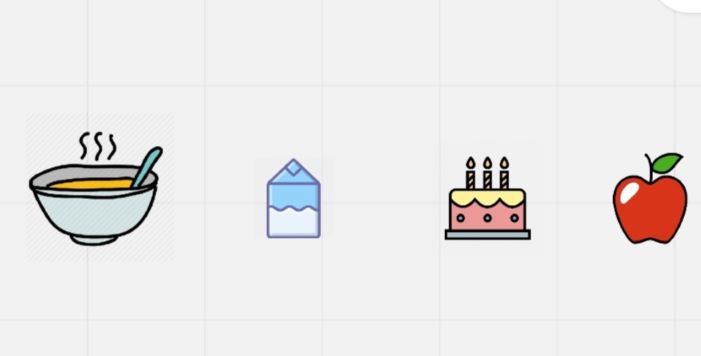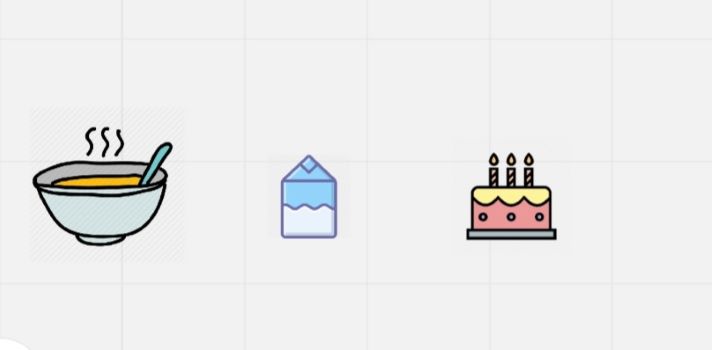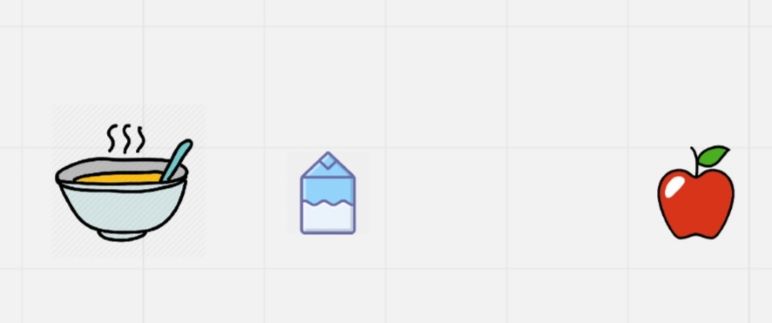Where to look for inspiration for pre-primary activities? Coursebooks will be probably the first point of reference for many of us, but not the only one. There are kids and their interests, too and this is how pets, favourite toys or books make an appearance in our lessons, Frozen and Co. There is the internet and what other people have created, used and share and we are really truly blessed to be teaching in the XXI century, with Instagram, Facebook and youtube. CLIL and ‘real subjects’ are another great source of inspiration even if our students learn English as a foreign language. Sometimes it also happens that we find some randomness and we really really really want to bring it to class and we design the whole lesson around a story, a glitter gun or our new puppet.
In this post I would like to focus on activities whose beginning and the main driving force was the development of the cognitive skills or, in other words, everything contributing to the development of the thinking skills: memory, focus, logic, connections, information processing, patterns etc.
Why?
- Because our students are 3 or 4 or 5 and 6 and they are developing these skills anyway. Using that and applying activities and concepts they are familiar with in their ‘L1 life’ to benefit of our English lessons is something that we do. This is how songs, chants, stories, crafts and puppets took over our classes.
- Because the kids will be drawn to them and motivated by this cognitive challenge. And this is how we are going to ‘trick’ them into producing the language.
- Because it would be simple be a waste not to use them.
How to do it? Keep on reading.
Categorising
This is something that can easily be done very early in the game, with the level 1 students and even with the younger pre-primary. ‘It’s big’ and ‘it’s small’ is probably one of the easiest concepts to start with. ‘You can eat it’ and ‘you can’t eat it’ is another. This is what I always start with because it is easy to demonstrate and even the youngest students giggle when you demonstrate ‘eating’ a pencil or a schoolbag.
Later on, the time comes for more complex categories, either based on personal preferences (I like it / I don’t like it) or the knowledge of the world (it’s hot / it’s cold, it can swim / it can fly / it can run or you eat it / you drink it).
Another, very simple way of applying this principle is categorizing objects by colour. These can be any objects that the students are familiar with, for example toys. The activity presented here was created for a 3-year-old student and used during the first week of the course. It went very well, the student was responding to the teacher pointing at different objects and responding to simple questions ‘Is it blue?’ with ‘Yes’ and ‘No’ but by the end of the lesson he started to produce his first chunks such as ‘a yellow car’, ‘a yellow robot’.
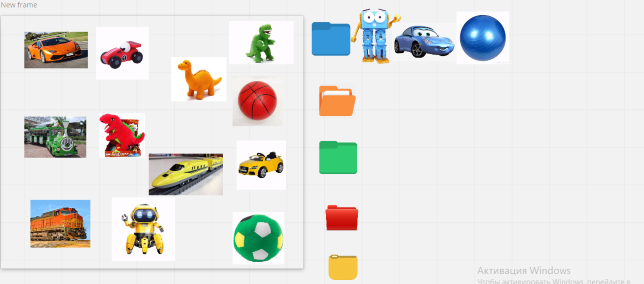
Odd one out
The inspiration for this and the following activity came from the Cambridge Young Learners Exams. The language level of these activities is, of course, way above the abilities of a typical year 1 or year 2 pre-primary student. However, cognitively, these are the tasks that preschoolers adore – looking for differences, similarities and connections and they will certainly be able to say ‘It’s blue, it’s blue, it’s blue. It’s red’
Most of the original exam materials can be used in class but with all the magic of the miro board preparing a task adapted to the needs and the level of the particular group will literally take two minutes.
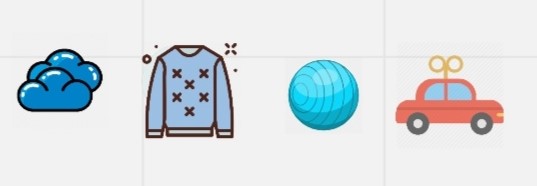
Find the difference
Again, this is a task that children are familiar with. However, the original exams tasks as well as the tasks intended for language practice might contain the language that is above the students’ level or might be too complex visually and too detailed, hence inappropriate. However, this problem can be solved quite easily by selecting two random illustrations of the topic of the unit ie the farm, as it has been done in the presented activity used in lesson with a 5 year old year 1 student (courtesy of pintrest.com and clipartart.com) and we produced sentences such as ‘I can see an orange cat’ and ‘I can see a grey cat’
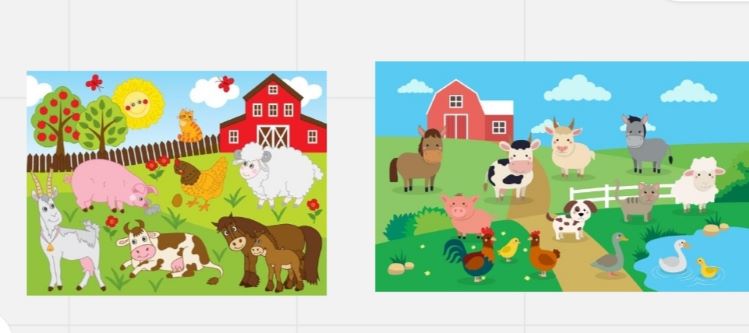
I spy with my little eye
It is a great game that does not require any preparation or special materials because that involves only looking around, listening and speaking. However, in its original form, it might be a little bit challenging for the EFL kids whose dictionary is very basic. For that reason, we play this game in a different way, based on a poster or a set of flashcards depicting only familiar vocabulary.
The most basic version ‘I spy with my little eye…something big’ can be easily extended into ‘I spy with my little eye…something big and pink’ or even ‘I spy with my little eye…something big and pink. It’s in the water. I like it’. The kids will be listening and speaking and required to process more complex information in order to complete the task.
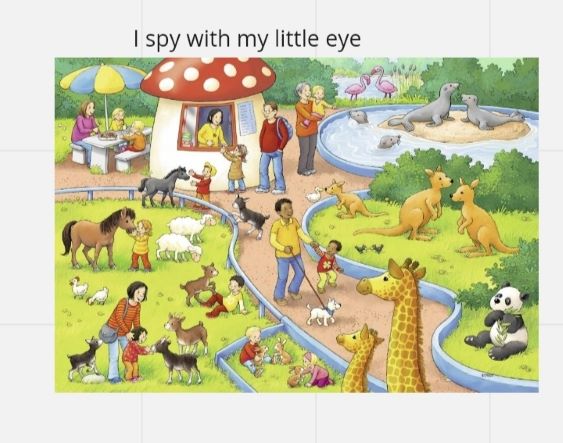
Shapes
For some reason, shapes, for some mysterious reason, are not one of the key topics in pre-primary coursebooks, despite their importance and general appeal. Luckily, it is easy to fill that gap and supplement.
You need to start with introducing the key vocabulary, at least the four basic shapes, but after this obstacle is dealt with, they can be used and referred to frequently. Creating familiar objects from shapes, counting them, calling out the colours is a fun activity and can be included in every unit, regardless of the topic. And we can look for shapes around us, in the classroom or in any picture we are dealing with.
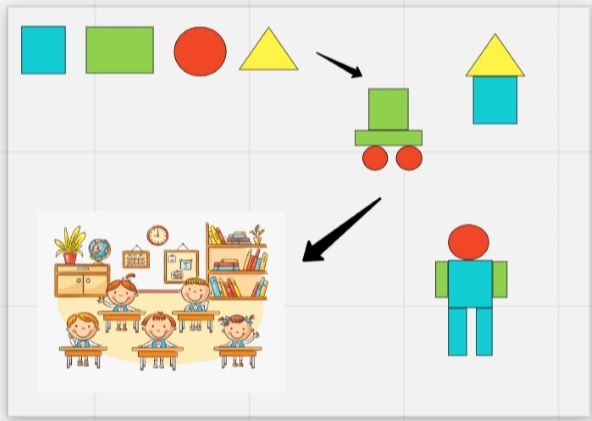
Sequence 1
This is a great activity that is especially useful in the first lessons with the new vocabulary as it really helps with drilling the single words or words in sentences. In the beginning the sequences can be very simple and straightforward, for example ‘robot, teddy, robot, teddy’ (or ‘It’s a robot, it’s a teddy’) but not necessarily. There are a lot of opportunities here and the students themselves can be involved in creating these.
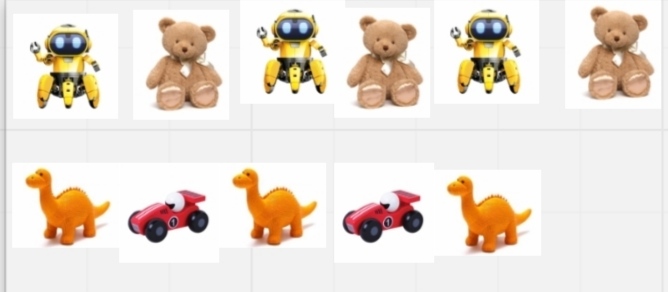
Sequence 2
Sequencing is not about figuring out and reciting what should go next but also which elements are missing in the set. In this lesson we were revising the foot items and there were four things in the set, something we eat, something we drink, something yummy and something good. We were counting and adding the missing elements. Later on, new sets were introduced and children were asked to say what is missing (something we drink) but they could choose their favourite drink ie milk, water, juice and so on.
P.S.
The basic overview of what cognitive skills are: here https://helpfulprofessor.com/cognitive-skills/
If you are interested in how the concepts change based on the level of cognitive skills of the human being, check out the 5 Levels series on youtube (https://www.youtube.com/watch?v=QcUey-DVYjk)
PPS
If you are interested in the topic of language production in pre-schooler, make sure you check out the posts on pairwork in pre-school, discourse clock, using songs and Colourful Semantics in EFL.
